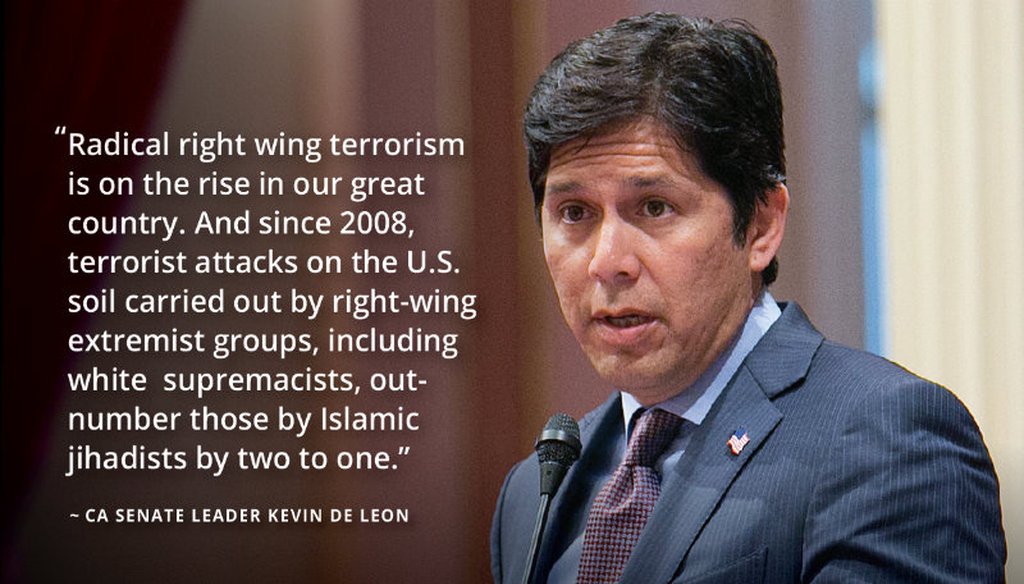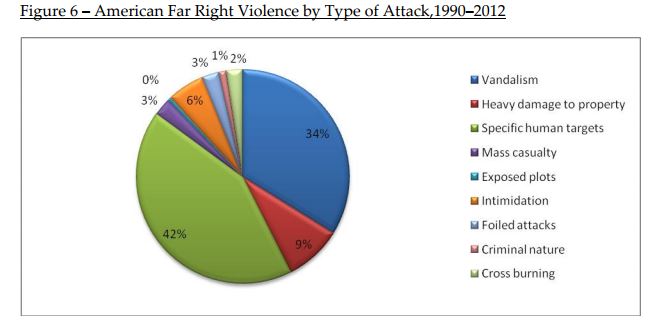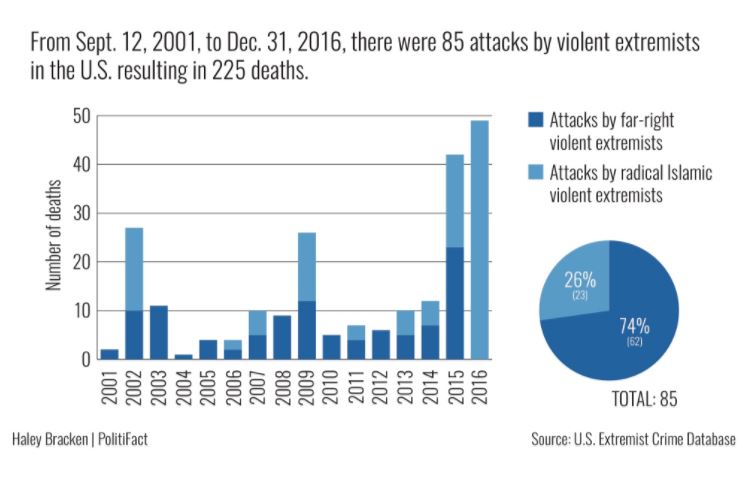Stand up for the facts!
Our only agenda is to publish the truth so you can be an informed participant in democracy.
We need your help.
I would like to contribute

California State Senate Leader Kevin de León made some bold claims about the rise of radical right wing terrorism following a deadly white supremacist attack in Charlottesville. / AP file photo
Following the deadly violence at a white nationalist rally and counter protest in Charlottesville, Virginia, politicians across the United States strongly condemned what’s been called an act of domestic terrorism.
Heather D. Heyer, 32, was killed and at least 19 others were injured after the driver of a Dodge Challenger drove into a crowd of people. Authorities charged a 20-year-old man from Ohio, James A. Fields Jr., with second-degree murder. Fields had marched in the white nationalist rally.
California State Senate Leader Kevin de León criticized President Trump for not explicitly condemning the white nationalists right after the attack.
Days later, when the California Legislature reconvened, the Democrat from Los Angeles called for hearings on what his office described as the rise of the white supremacist movement.
De León made additional remarks at the state Capitol on Aug. 21 that caught our attention:
"Radical right wing terrorism is on the rise in our great country. And since 2008, terrorist attacks on the U.S. soil carried out by right-wing extremist groups, including white supremacists, outnumber those by Islamic jihadists by two to one. That is a statistical fact."
De León makes his claim at the 5:20 minute mark above.
Was de León right? We set out on a fact check.
Evidence not clear-cut
We asked de León’s spokesman for information supporting the claims. He pointed to several news articles and reports, which we’ll explore below.
After we sorted through the data and spoke with experts on terrorism, however, we found that the evidence is not as clear-cut as the senator suggests. Researchers told us there’s ambiguity, for example, about what constitutes a terrorist attack versus a plot, a hate crime or simply an act of violence. Experts also say it’s difficult in some terrorism cases to pinpoint the exact ideology of the attacker.
Several studies show there have been more terror related incidents or events involving right-wing extremists compared with Islamic jihadists. Many of these, however, were foiled plots that never resulted in an actual attack. De León’s statement uses the phrase "carried out," suggesting an attack that took place, not one that was stopped. One point that is clear from the research: Islamic terror attacks on U.S. soil, though less frequent, have been much more deadly per attack.
We won’t rate de León’s claim on our Truth-O-Meter due to the lack of clarity on definitions of terror attacks and ideology, even among academics and U.S. government agencies. But we will outline the available facts about terrorism by right wing extremists and how their attacks compare with those by Islamic jihadists.
First, let’s look at the definition of terrorism.
The Global Terrorism Database at the University of Maryland defines a terrorist attack as "the threatened or actual use of illegal force and violence by a non-state actor to attain a political, economic, religious, or social goal through fear, coercion, or intimidation."
Most researchers agree that an act of terror must be intentional and include some level of violence, though how much is often debated.
Academics and even some U.S. government agencies have varying definitions, some more strict, others loose. Extremist violence has come to stand in for terrorism in much of the reporting on the subject.
"Ordinary citizens, the media, and politicians throw around the term ‘terrorism’ so loosely that in ordinary conversation it has lost all but the most vague meanings," Lance Janda, a military historian at Cameron University in Lawton, Okla., told PolitiFact in 2013. "Some folks use it as a catch-all term to describe attacks or events that they don't like rather than being more precise."
Is radical right wing terrorism ‘on the rise’ in the United States?
We’ll start with the first part of de León’s claim: "Radical right wing terrorism is on the rise in our great country."
A study published in 2012 by the Combating Terrorism Center at West Point generally supports this, though its data is not definitive nor as current as other studies. De León’s office pointed to a news article that cites this report.
The West Point study examined acts of political violence by far right groups -- though not explicitly terrorist attacks -- from the early 1990s through 2011. It says many of these attacks can be considered terrorism.
"In the last few years, and especially since 2007, there has been a dramatic rise in the number of attacks and violent plots originating from individuals and groups who self-identify with the far-right of American politics."
The report adds the "overall trend is very clear: from the early 1990s until 2008 there has been a clear increase in the number of attacks. Fourteen of the 21 years covered in this analysis witnessed more attacks than the previous year. Although in the 1990s the average number of attacks per year was 70.1, the average number of attacks per year in the first 11 years of the twenty-first century was 307.5, a rise of more than 400%."
The report documents all types of political violence by right wing groups. The author says this includes terrorism but is not strictly limited to that type of attack. It found 43 percent of the attacks were directed against property and 42 percent against specific individuals and just 3 percent were intended to cause mass casualties.
SOURCE: Combating Terrorism Center at West Point, "Challengers from the Sidelines: Understanding America’s Violent Far-Right," 2013
Alex Nowrasteh, a policy analyst at the libertarian Cato Institute who has studied terrorism, says tallying attacks is problematic.
"My terrorism research focuses on deaths committed by terrorists because that is the easiest and the least ambiguous metric to analyze the damage committed by terrorism," Nowrasteh wrote in an August 2017 commentary. "Attacks could be as minor as a pipe bomb left by a bulldozer that explodes at 2:30 a.m., or as deadly as the 9/11 attacks that killed 2,983 people and caused billions in property damage, so counting the number of attacks by ideology does not reveal much."
Recent surge in right-wing terror ‘incidents’
A 2017 report by the Anti-Defamation League also appears to support the first portion of de León’s claim, though again it doesn’t specifically count terrorist attacks. Instead, the report describes a surge of right-wing "terror incidents" starting in the the mid-2000s through 2016. Also, the report found that only 65 of the 150 right-wing terror incidents logged since the early 1990s resulted in what could be considered a "successful" act.
Do right wing extremists commit twice as many terror attacks in U.S. as Islamic jihadists?
This second part of de León’s claim is subject to the same complexity of definitions as the first.
De Leon’s spokesman pointed to several sources, including an investigative news article by Reveal. Its findings most closely mirror the senator’s statement but also include key context not captured by de León’s words.
Reveal reported finding nearly twice as many terror "incidents," 115, tied to right-wing extremists compared with terror "incidents" tied to Islamist groups from January 2008 through the end of 2016.
Many of the incidents involving right wing and Islamist extremists were foiled, Reveal reported. Those carried out by the far-right wing groups more frequently involved a fatality. Still, the total deaths associated with Islamist cases were higher.
As one expert told us, Islamic attacks have been "more lethal per attack."
More deaths, fewer attacks
An April 2017 report from the U.S. Government Accountability Office builds on this idea.
It examined terrorist violence from Sept. 12, 2001 -- the day after the 9/11 terror attacks -- through Dec. 31, 2016. It found 85 deadly attacks in the United States by violent extremists resulting in 225 deaths, according to the GAO report.
The report defines violent extremism as supporting or committing violent acts to achieve political, ideological, religious or social goals -- a definition similar to that for terrorism. The term jihadism has has been applied to Islamic militant and terror movements against the West.
PolitiFact recently examined the GAO report and found, like the Reveal investigation, that more attacks were carried out by far-right violent extremists. But more people died during attacks connected with Islamic jihadists.
Of those 225 deaths by extremists:
• 106 individuals were killed by far-right violent extremists in 62 separate incidents;
• 119 individuals were killed by radical Islamist violent extremists in 23 separate incidents;
Brian Levin, director of the Center for the Study of Hate and Extremism at California State University San Bernardino agreed there are far more incidents of terrorism involving right wing extremists. The Islamic jihadist inspired attacks, however, have garnered more attention in the United States because they’ve been much more lethal. He cited the example of the Orlando nightclub shooting in 2016 in which a man claiming allegiance to the Islamic terror group ISIS killed 49 people.
Pinpointing ideology a challenge
Erin Miller manages the Global Terrorism Database at the University of Maryland.
Miller said pinpointing the ideology of a terrorist is fraught with challenges. Despite her project’s extensive records, she said she couldn’t confirm or reject de León’s statement because the database does not include an in-depth rationale for why a person commits a terror attack.
"There’s some cases where it’s very difficult to know" an attacker’s ideology, Miller said. "Even if you have an individual identified, people are complicated. A particular individual that might have been associated with a white supremacist group at one point in time but it’s not clear that (later on) they carried out this specific attack to further that agenda."
Miller added that tallying terror attacks by ideology "should not be used to end debate on who’s worse." She said terrorism is just one narrow kind of violence.
Conclusion
In the end, we found evidence that generally supports the first part of de León’s claim -- that radical right wing terrorism is on the rise. Still, there’s a lack of agreement among experts and even within the U.S. government over how to define terrorism. As a result, some studies show political violence is on the rise among far right wing groups, but do not explicitly call all of these crimes terrorist attacks.
The second part of de León’s statement, comparing terror attacks by ideology, is also complicated. What’s clear is that far right groups have been tied to more terror incidents, often to deadly attacks or property damage. Meanwhile, Islamic jihadist inspired groups, while responsible for fewer terror attacks, have killed far more people on U.S. soil in recent decades.
We won’t rate the senator’s claim as it doesn’t fit neatly on our Truth-O-Meter. While generally on the right track, de Leon’s words could have used some additional context given the complexity of the topic.
Our Sources
California State Sen. Kevin de León, speech, Aug. 21, 2017
Anthony Reyes, spokesman State Sen. Kevin de León, email exchange Aug. 25, 2017
Brian Levin, director, Center for the Study of Hate and Extremism, California State University San Bernardino, interview Aug. 28, 2017
Erin Miller, program manager, Global Terrorism Database, National Consortium for the Study of Terrorism and Responses to Terrorism, University of Maryland, interview Aug. 25, 2017
Alex Nowrasteh, immigration policy analyst, Cato Institute, Center for Global Liberty and Prosperity, interview Aug. 28, 2017
Reveal, Charlottesville underscores how homegrown hate is going unchecked, Aug. 14, 2017
PolitiFact, "A look at the data on domestic terrorism and who’s behind it," August 16, 2017
Snopes.com, "Who is More of a Threat: Far-Right or Muslim Extremists?" June 7, 2017
Combating Terrorism Center at West Point, "Challengers from the Sidelines: Understanding America’s Violent Far-Right," Jan. 15, 2013
United States Government Accountability Office, "Countering Violent Extremism," April 2017
PolitiFact, What's the definition of 'terrorism'?, July 9, 2013
Cato Institute, Terrorism Deaths by Ideology: Is Charlottesville an Anomaly?, Aug. 14, 2017
Cato Institute, Which Ideology Has Inspired the Most Murders in Terrorist Attacks on U.S. Soil?, Aug. 21, 2017
Anti-Defamation League, A Dark and Constant Rage: 25 Years of Right-Wing Terrorism in the United States, accessed August 2017




 PolitiFact Rating:
PolitiFact Rating: 

















































